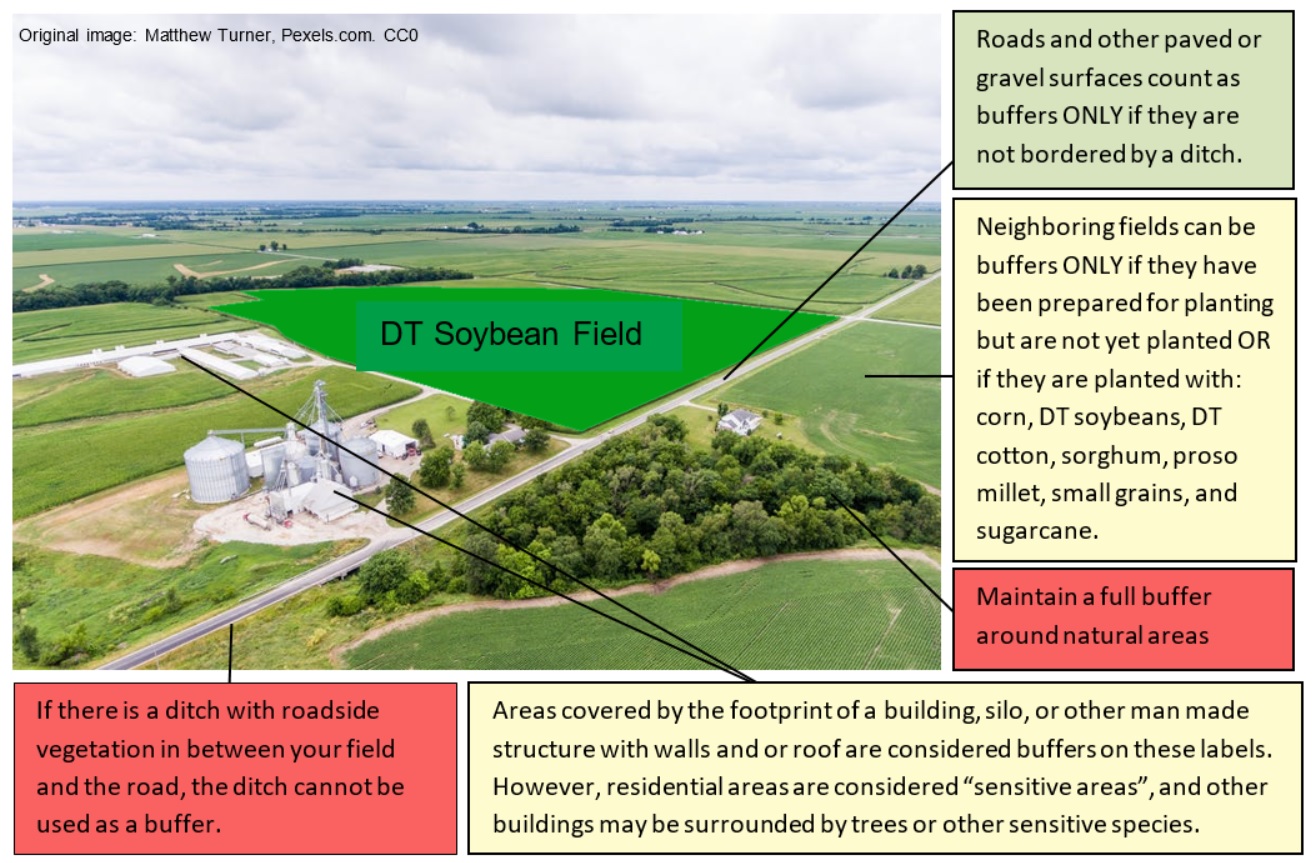Buffers are one important tool in reducing off-target movement of pesticides to neighboring crops and sensitive areas. Given the high number of off-site movement complaints in 2017, particularly for dicamba in the Upper Midwest, applicators need to take special care this year. The following guidelines will help explain the label-mandated dicamba buffer requirements for 2018.
1. What size does my buffer need to be?
The three new dicamba formulations have slightly different buffer size requirements, so it’s important to pay attention to the specific label for the dicamba product you plan to use. In all cases, buffer sizes are not suggestions; they are legally mandated by the label. If there are waterways, native vegetation areas or other sensitive sites near your field, consider a larger buffer distance than the minimum mandatory distances given in the table below. Applicators are held liable in all cases of off-target movement.
|
Product
|
Registrant
|
Single Application Rate
|
Required Minimum Downwind Buffer Distance
|
|
XtendiMax® with
VaporGrip®
technology
EPA reg. No. 524-617
|
Monsanto
|
22* fluid oz./A
|
110 feet
|
|
>22* up to 44† fluid oz./A
|
220 feet
|
|
DuPont™ FeXapan™ with
herbicide Plus
VaporGrip®
Technology
EPA reg. No. 352-913
|
DuPont
|
22* fluid oz./A
|
110 feet
|
|
>22* up to 44† fluid oz./A
|
220 feet
|
|
Engenia® herbicide
EPA reg. No. 7969-345
|
BASF
|
12.8* fluid oz./A
|
110 feet
|
*equivalent to 0.5 lbs. of dicamba ae/A
† equivalent to 1 Lb of dicamba ae/A
For all pre-plant, pre-emergence or post-emergence applications, the buffer zone is required only in the downwind direction of the field. However, if the wind is blowing at an angle relative to field edges, buffers must be maintained on both downwind edges of the field. It is advisable to check wind direction and speed not just at the start and finish, but during an application, as wind patterns may change over the application period.
2. What counts as a buffer?
Roads and other paved or gravel surfaces count as buffers only if they are not bordered by a ditch.
Neighboring fields can be buffers only if they have been prepared for planting but are not yet planted, or if they are planted with corn, dicamba-tolerant (DT) soybeans, DT cotton, sorghum, proso millet, small grains or sugarcane.
A full buffer needs to be maintained around natural areas.
Areas covered by the footprint of a building, silo or other manmade structure with walls and/or a roof are considered buffers on these labels. However, residential areas are considered “sensitive areas,” and other buildings may be surrounded by trees or other sensitive species.
If there is a ditch with roadside vegetation between your field and the road, the ditch cannot be used as a buffer.

3. What crops are susceptible?
All applicators are required to survey the site for neighboring non-target susceptible crops before spraying. Applicators must also consult applicable sensitive crop registries to identify any commercial specialty or certified organic crops that may be located near the application site. (For examples, visit www.driftwatch.org.) If the wind is blowing in the direction of a susceptible crop, do not spray until the wind has changed direction. Spraying is forbidden in these circumstances, even with a buffer. Dicamba-susceptible crops include:
- Non-DT soybeans
- Cucumbers and melons (EPA crop group 9)
- Flowers
- Fruit trees
- Grapes
- Ornamentals, including greenhouse-grown and shadehouse-grown broadleaf plants
- Peanuts
- Peas and beans (EPA crop group 6)
- Peppers, tomatoes and other fruiting vegetables (EPA crop group 8)
- Potato
- Sweet potato
- Tobacco
4. What does “neighboring” mean?
Any sensitive plant species or sensitive area located next or adjacent to a DT soybean field or next to the required downwind buffer distance would be considered “neighboring.” The spray system and weather-related factors determine the potential for spray drift. The applicator is responsible for considering these factors when making application decisions to avoid spray drift onto non-target areas. Be sure to check for sensitive areas and susceptible crops by using tools like DriftWatch and consulting with your neighbors before spraying dicamba products.
5. Application requirements to reduce the potential for off-target movement
- Spray only when wind speeds are between 3 and 10 miles per hour, measured at boom height.
- Do not spray during temperature inversions.
- Spray only after sunrise and before sunset.
- Lower boom heights: no more than 24 inches above target crop or weed canopy.
- Use minimum of 10 gallons per acre of spray volume for Engenia and 15 gallons per acre for XtendiMax and FeXapan products.
- Do not exceed a ground speed of 15 miles per hour.
- Avoid spraying in hot, dry conditions. Droplets are more likely to evaporate when humidity is low.
- Check the specific product website no more than seven days before application for a complete list of nozzles, drift reduction agents and other herbicides, pesticides and additives approved for use with the product.
- Some products should not be applied after certain dates. Contact local extension experts for these requirements in your area.